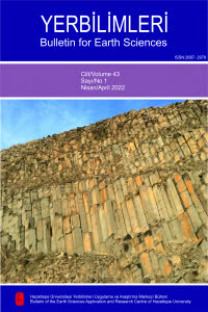Implications of GPS-derived displacement, strain and stress rates on the 2003 Miyagi-Hokubu earthquakes
Deprem tahmini uzun yıllardan beri çok önemli bir araştırma alanı olup, Japonya'da Tokai Deprem Tahmini Projesi ve ABD'de Parkfield Deprem Tahmin Projesi bu amaç için yürütülen projelerin belli başlılarıdır. Yazarın daha önceki bir makalesinde (Aydan, 2000) gösterildiği gibi, GPS yerkabuğu deformasyon ölçümlerinden elde edilen birim deformasyon ve gerilme hızlarını kullanarak deprem riskinin çok yüksek olabileceği alanların saptanabileceği kanıtlanmıştır. Japonya ve ABD'de yoğun GPS ağlarından elde edilen günlük ölçümlerden birim deformasyon ve gerilim hızları deprem öncesi yerkabuğunun davranışının anlaşılması ve deprem oluş zamanının kestirimi açısından oldukça yararlı olacaktır. Bu çalışmada ise, Aydan (2000) tarafından önerilen yöntem Japonya'da Miyagi vilayetinin kuzey kısmında 1998-2003 yılları arasında alınan günlük ölçümlere uygulanmıştır. GPS ölçümlerinden elde edilen deformasyonlar, bölgesel tektonik hareketlerle uyum içerisinde olmamakla birlikte, elde edilen birim deformasyon hızları ile gerilim hızları faylanma mekanizmasından beklenenlerle uyum içerisindedir. Özellikle tanımlanan ortalama, en büyük makaslama ve kırılabilirlik gerilim hızlarının deprem riskinin yüksek olduğu alanların saptanmasında oldukça yararlı olduğu bir kez daha kanıtlanmıştır. GPS yönteminin yakın gelecekte örneğin hafta ve ay mertebesinde deprem tahmininde kullanılabilir olduğuna şüphe yoktur. Bununla birlikte, çok yakın gelecekte başka bir deyişle saat mertebesinde deprem tahminine uygulanabilir olabilmesi için ölçüm hassasiyetinin oldukça arttırılması gerekmektedir.
2003 Miyagi-Hokubu (Japonya) depremleri için GPS 'ten elde edilen yer değiştirme, birim deformasyon ve gerilme hızlarının değerlendirilmesi
Earthquake prediction has been an important field of research for years and some earthquake prediction projects such as the Tokai Earthquake Prediction Project in Japan and the Parkfield Earthquake Prediction Project in USA have been recently undertaken to progress on short-term prediction. As also shown by the author, the stress rates derived from the GPS deformation rates can be effectively used to locate the areas with high seismic risk. Furthermore, daily variations of derived strain-stress rates from dense GPS networks in Japan and USA may provide a high quality data to understand the behaviour of the earth's crust preceding earthquakes and also to predict the occurrence time of earthquakes. In this study, the method proposed by Aydan (2000) is applied to the daily GPS measurements in the northern part of Miyagi prefecture during the period between 1998 and 2003. Although the responses of deformation velocities of stations obtained from the GPS are not generally consistent with the plate tectonics model of the region, the regional strain and stress rates are in accordance with those expected from the faulting mechanism of the earthquakes. It is shown that the mean, maximum shear and disturbing stress rates can be quite useful for identifying the areas with high seismic risk in addition to tilting strains and associated stresses obtained in this article. They may be further useful for near future (in the order of months) earthquake prediction. However, they can not be used for the very near future (of the order of several hours to days) predictions unless the precision of measurements is substantially improved.
___
Aydan, Ö., 1997. Dynamic uniaxial response of rock specimens with rate-dependent characteristics. Proceedings of the South African Rock Engineering Symposium, Johannesburg, SARES 97, 322-331.Aydan, Ö., 2000. Annual strain rate and stress rate distributions of Turkey from GPS Measurements, Yerbilimleri, 22, 21-32.
Aydan, Ö., 2002. Actual observations and numerical simulations of surface fault ruptures and their effects on engineering structures. 8th Workshop on Earthquake Resistant Design of Lifeline Facilities and Countermeasures against Liquefaction, Tokyo, Japan.
Aydan, Ö., 2003. The earthquake prediction and earthquake risk in Turkey and the applicability of global positioning system (GPS) for these purposes. Turkish Earthquake Foundation, TDV/KT 024-87, 1 -73 (in Turkish).
Aydan, Ö., and Nawrocki, P., 1998. Rate-dependent deformability and strength characteristics of rocks. Proceeding of the International Symposium on the Geotechnics of Hard Soils-Soft Rocks, Napoli, 1, 403-411.
Aydan, Ö., Ulusay, R., Yüzer, E., Erdoğan, M., and Kawamoto, T., 1999. A research on the living environment of Derinkuyu Underground City, Central Turkey. (MONBUSHO Research Project No: 09044154) (in Japanese).
Aydan, Ö., Kumsar, H., and Ulusay, R., 2000. The implications of crustal strain-stress rate variations computed from GPS measurements on the earthquake potential of Turkey. International Conference of GIS on Earth Science and Applications. ICGESA-2000, Menemen (on CD).
Aydan, Ö., Kumsar, H. and Ulusay, R., 2002. How to infer the possible mechanism and characteristics of earthquakes from the striations and ground surface traces of existing faults, JSCE, Earthquake and Structural Engineering/Earthquake Engineering, 19 (2), 199-208.
Aydan, Ö., Tokashiki, N., Ito, T., Akagi, T., Ulusay, R., and Bilgin, H. A., 2003. An experimental study on the electrical potential of nonpiezoelevtrik geomaterials during fracturing and sliding, Proceeding of the 9th ISRM Congress, South Africa, 73-78.
Eringen, A.C., 1980. Mechanics of Continua, R.E. Krieger Pub. Co., New York. Fowler, C.M.R., 1990. The solid earth - An introduction to Global Geophysics, Cambridge University Press, Cambridge.
Jaeger, J.C. and Cook, N.G.W., 1979. Fundamentals of Rock Mechanics, 3rd Edition, 593 pp. Chapman and Hail, London.
Öncel, A., and Aydan, Ö., 2003. Variations in GPS-derived displacement and stresses during the 2003 Miyagi earthquakes. Proceeding of the International Colloquium on Instrumentation and Monitoring of Landslides and earthquakes in Japan and Turkey, Koriyama, (H. Tano and Ö. Aydan (eds.)), 81-90.
Tokashiki, N., and Aydan, Ö., 2003. Characteristics of Ryukyu Limestone and its utilization as a building stone in historical and modern structures. Proceeding of the International Symposium on Industrial Minerals and Building Stones, İstanbul, 311-318.
- ISSN: 1301-2894
- Başlangıç: 1976
- Yayıncı: Hacettepe Üniversitesi Yerbilimleri Uygulama ve Araştırma Merkezi
Sayıdaki Diğer Makaleler
Feldispat cevherinden mikanın spiral zenginleştirici ile uzaklaştırılması
MURAT KADEMLİ, Özcan Y. GÜLSOY
Validity of the "rubbing" method for the field determination of the shear sense of a fault surface
Ebru Coşkun DELİBAŞ, Yurdal GENÇ
Güncel bir foraminifer; Amphicoryna scalaris (Batsch)
Engin MERİÇ, Niyazi AVŞAR, Fulya BERGİN
Gediz ayrılma zonu: Fay kayacı stratigrafisi ve tektonik önemi
Güre (Giresun, KD Türkiye) granitoyidinin petrografik, jeokimyasal ve petrolojik özellikleri
Mehmet ARSLAN, Hasan KOLAYLI, İrfan TEMİZEL
Mahmut G. DRAHOR, Gökhan GÖKTÜRKLER, Meriç A. BERGE, T. Özgür KURTULMUŞ
Çamardı (Niğde) yöresi Tersiyer (Lütesiyen) sedimanlarının bentik foraminifer biyostratigrafisi
